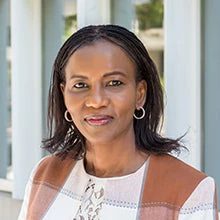 Refugee families wait at a food distribution point. © 2018 European Union (photo by Dominique Catton)
Refugee families wait at a food distribution point. © 2018 European Union (photo by Dominique Catton)
Earlier this month, I had an opportunity to visit the World Bank-UNHCR Joint Data Center on Forced Displacement (JDC) in Copenhagen, Denmark. The UNHCR has just documented a record 100 million refugees, internally displaced and stateless persons. However, there are huge data gaps in terms of the socioeconomic conditions of those displaced – including their health, education, and/or income levels. Obtaining this information is crucial to our interventions, as well as those of governments, particularly in designing policies.
Established in 2019, the JDC aims to address that need with a mandate to improving the quantity, quality and availability of socioeconomic data about those who have been forced to flee, as well as the communities that host them. The goal is to help the international community to make evidence-based decisions that can protect and improve the well-being of affected people.
During the COVID-19 pandemic, the World Bank conducted high-frequency phone surveys around the world to better understand how people were being impacted. The JDC helped to also include those who were forcibly displaced in several of these surveys. As a result, more than 100,000 interviews were conducted with displaced households in 10 major host countries. This has allowed the Bank, the UNHCR and other stakeholders to understand how this particularly vulnerable group fared in terms of work, income, food security, school enrolment, and access to health. This data facilitated the development of better policies and more targeted interventions.
With the number of refugees doubling in the last decade, the World Bank Group has stepped up its work on forced displacement. Since 2019, the International Development Association (IDA) has approved 56 projects for a total of $2.9 billion. These projects are targeted at refugees and their host communities in 18 of the world’s poorest countries. For middle-income countries, the Global Concessional Financing Facility has provided almost $800 million worth of grants, thereby unlocking almost $6 billion in concessional financing. Beyond financing, as a development institution guided by data and evidence, the Bank also aims to add value through its analytical capacity. This involves not only collecting data, but also putting it into a wider development context for countries to access and use.
On my visit, I learned about JDC-supported work in Chad. Despite being one of the poorest countries in the world, Chad has a decades-long history of generosity in accepting refugees. Indeed, they now host a half a million refugees. While national programming has census and poverty surveys to rely on, displaced households were living in the statistical shadows. Displacement-related programming has, at best, relied on guesstimates.
The Chadian Government asked the Bank and the UNHCR how they could transition from humanitarian relief to a longer-term development and integration plan. As a first step, the JDC supported the analysis drawing on 2018-19 data from a groundbreaking country-led representative survey concerning Chadian and refugee households. This data was collected by the National Statistical Office (NSO) in Chad. Second, innovative phone surveys were conducted during the pandemic. Together, these two efforts allowed for comparisons of host and displaced populations pertaining to food security, income, and education both immediately before and during the pandemic.
The surveys found that 82 percent of refugee households experienced severe food insecurity during the pandemic, as compared to 54 percent of Chadian households. Poverty and income data showed similar divergences between refugees and Chadian households. As a step forward, Chad passed an inclusive Asylum Law in December 2020, guaranteeing freedom of mobility and equal access to health, education, and justice. The country is now using this data to facilitate the targeting of the Bank’s social protection program to help host communities and refugees. Chad’s National Statistical Office (NSO) is also extending its precedent of statistical inclusion by integrating refugees into the next round of its national household survey.
Chad is an example of how the JDC has supported a new generation of data, facilitating the development of unique insights to inform inclusive policy and programming, thus improving the lives of some of the most vulnerable people in the world. It is important to place this data in the public domain, ensuring universal access. Thanks to the collaboration between the UNHCR and the Bank through the JDC, the UNHCR now has a microdata library with some 430 datasets from numerous displacement contexts. These datasets have been carefully curated, cleaned, and anonymized to ensure the protection of the individuals behind the numbers.
Finally, with the war in Ukraine, we are witnessing a rapidly unfolding humanitarian and refugee crisis. Our strengthened collective knowledge is now being deployed to offer advice to governments hosting Ukrainian refugees. We have come a long way in better understanding what works in terms of policies and programmatic interventions to benefit those forcibly displaced, as well as their hosts. Solid data, backed by sound analysis, is one of the first essential steps on that journey.


Join the Conversation